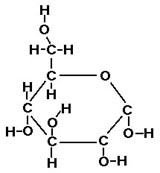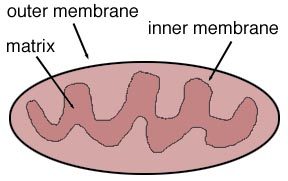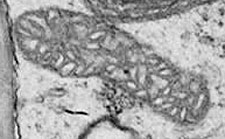BIOL 1400 -- Lecture Outline 35
"There is science, logic, reason; there is thought verified by experience. And
then there is California." --Edward Abbey
I. Glycolysis: the first step in ATP production
- The starting point for glycolysis is the six-carbon sugar glucose.

Glucose
- More complex carbohydrates that you eat -- table sugar and starches -- are
broken down into glucose before glycolysis can start.
- If you're "burning" fats, they feed into the process of glycolysis
"farther down the line".
- What happens next is a series of chemical reactions, each of which is
catalyzed by a specific enzyme.
- The cell uses up two molecules of ATP in the first two steps. . .
- . . . breaks the sugar into two molecules with three carbons each. . .
- . . . rearranges them a bit, and gets two molecules of pyruvate
(CH3COCOO-). . .
- . . . and also gets four molecules of ATP, making a net gain of two ATP. . .
- . . . and into the bargain, the cell picks off two hydrogen atoms and combines those
with two molecules of nicotinamide adenine dinucleotide to get two molecules
of nicotinamide adenine dinucleotide hydride. We will mercifully refer to
these molecules by their initials, NAD+ and NADH.
- So here's the "balance sheet" so far:
C6H12O6 + 2 NAD+ + 2 ADP +
2 Pi = 2 pyruvate + 2 NADH + 2 ATP
And here's an animated
diagram of the details of glycolysis. You will not have to memorize the
details, but it may help you to view this to see, atom by atom, what the heck
is going on.
II. Cellular Respiration
- Cellular respiration takes place in the mitochondria. (You do know what
those are by now, right?)
- For those of you who forgot. . . Mitochondria look like this:

Diagram of a mitochondrion

Cross-section through an actual mitochondrion
- It starts when the pyruvate from glycolysis is transported into the innermost
part of the mitochondria, the matrix. . .
- Each pyruvate molecule combines with a molecule called coenzyme A,
forming acetyl-CoA and giving off one molecule of carbon dioxide.
- Each acetyl-CoA molecule feeds into a series of reactions that goes in a
circle and ends up where it started. This is the Krebs cycle. (Here's an
animated diagram
of the details of the Krebs cycle. You won't be tested on it, but it might be
helpful for your understanding.)
- At the end of each "turn" of the Krebs cycle, we have generated two more
CO2 (in addition to the one created when we went from pyruvate to
acetyl CoA).
- Remember that two pyruvates are produced for each molecule
of glucose. . . so in all, each molecule of glucose yields six CO2.
- We've also, however, produced six more NADH from NAD+, plus two
molecules of a similar substance, FADH2 from FAD+.
(FADH2) is short for flavin adenine dinucleotide hydride. But
let's just keep it FADH2, shall we?)
- And by the way, we've also produced two more ATP.
III. Now what? Electron transport!
- The inner membrane of the mitochondrion contains many proteins that are going
to be important here.
- Some of them make up the electron transport system.
- Another, extremely important membrane protein -- whose discoverers won
the Nobel Prize a couple of years ago -- is ATP synthase.
- Remember all that NADH and FADH2? Those molecules are
called electron carriers, and here's why: They go over to the inner
membrane of the mitochondrion, and pass electrons to the first protein in
the electron transport system.
- These electrons get passed from protein to protein, down the transport system. . .
- . . . and at the end of the road, the electrons combine with protons and with
oxygen, to make. . . water.
- That's why you have to breathe oxygen to live.
If you didn't, your electrons would have nothing to combine with at the end of
the electron transport system, and the whole system would grind to a halt.
- We say that oxygen is the terminal electron acceptor.
- And what's the point of that? As the proteins in the transport system
are passing these electrons along, they pick up energy from the electrons. . .
- . . . and can use that energy to pump protons (H+) across the inner
membrane of the mitochondrion!
- Eventually, you get few protons inside the inner membrane of the mitochondrion,
and many in the space between the outside and the inside.
- Now those protons would flow back through the inner membrane. . .
- But they can only do that by passing through a specialized protein "gate"
molecule, ATP synthase.
- ATP synthase has a pore in it, through which H+ ions (protons)
can pass.
- As they pass through, the protons give up
some energy to the ATP synthase molecule, which uses it to create ATP from
ADP + Pi.
- (Analogy: Think of a watermill. As water falls, it can pass its
kinetic energy to the millwheel, which in turn can drive a machine that makes
something.)
- This process, of using energy from proton flow across a membrane to make ATP, is
chemiosmosis. Here's
a diagram of what it looks like.
- ATP synthase picks up energy off the proton flow, and uses that to make ATP.
- In fact, each glucose molecule yields 32 or 34 molecules of ATP through
chemiosmosis (the precise number is different in different organisms). Add that
to the ATP already generated by glycolysis and the Krebs cycle, and you get 36 to
38 molecules of ATP for each molecule of glucose.
Here's the balance sheet for the whole thing:
C6H12O6 + 6 O2 ->
6 CO2 + 6 H2O + chemical energy (ATP)
IV. Fermentation
- The entire process of respiration depends on oxygen being present.
- If there's oxygen present, the pyruvate and NADH go on to cellular respiration,
which we just covered.
- If not, the cell has to find a way to use up the pyruvate and NADH.
- Different organisms have slightly different ways to pull this trick off, but
they're all called fermentation.
- Many eukaryotes, including you, convert pyruvate to lactic acid (using
up the NADH in the process).
- Buildup of lactic acid in your muscles is responsible for feeling tired and cramping.
- The bacteria that ferment milk into yogurt, buttermilk, soft cheese, etc. also
create lactic acid by fermentation.
- Other bacteria convert pyruvate to acetic acid -- a.k.a. vinegar.
- Other organisms, notably the eukaryotic fungi known as yeasts, ferment
pyruvate to ethanol and carbon dioxide gas.
- Add yeast to a sugary solution such as grape juice, and you get wine or hard
cider. If you trap the carbon dioxide during the fermentation, you get champagne or
sparkling wine. If you let the carbon dioxide escape during fermentation, you
get still wine.
- Beer also relies on yeast for both its alcohol and its bubbles, but there's another
step involved. . .
Go to Previous Notes |
Return to Lecture Schedule |
Return to Syllabus |
Contact the Prof |
Go to Next Notes


